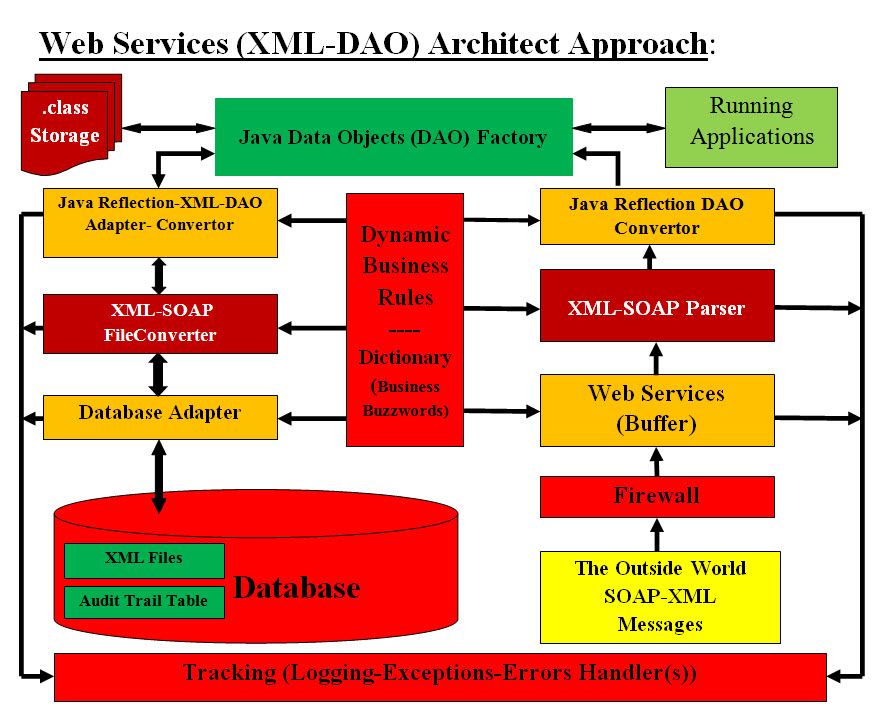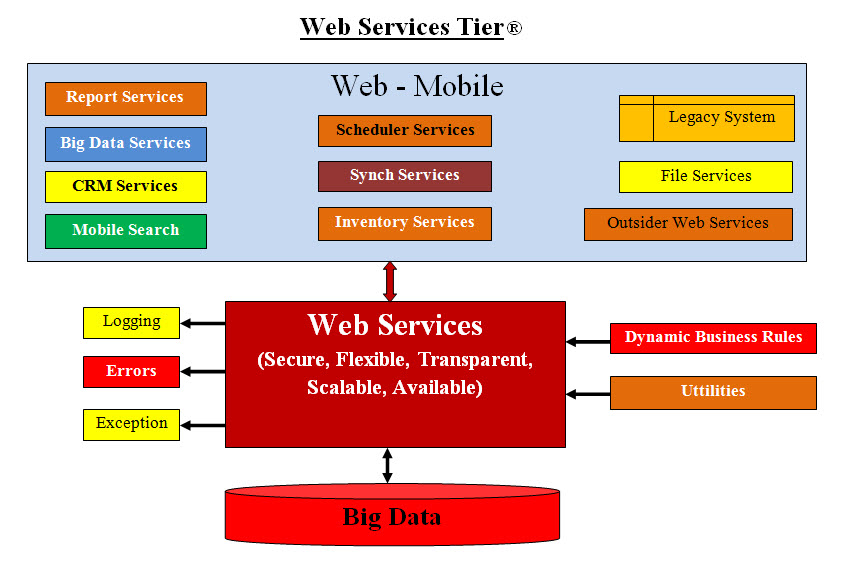|
Web Services
Introduction Web services provide a cost-effective way of distributing corporate data. A web service enables communication among various applications by using open standards such as HTML, XML, WSDL, and SOAP. A web service takes the help of: XML to tag the data SOAP to transfer a message WSDL to describe the availability of service. SOAP: Communicate with the Web Service Both the request and the response are SOAP messages The body of the message (whose grammar is defined by the WSDL) is contained within a SOAP envelope Binds the client to the web service Security: Web services must have security features since it is the connection to the outside world. Use Case: Web Services Description: Web services implementation varies from one company to another. It can be as simple as sending "Hello World" or as complicated as eight level nesting XML code with a very complex schema. Such nested XML code and schema would take six months for an IT engineer to fully comprehend it. Another issues is that every project may have its own special ingredients plus there is a learning curve for a new starter. Briefly Describe This Use Case How to simplify and automate web services is our goal and we are expecting skeptics disagreement. Our architect is an option for companies to use. To simplify web services, we need to eliminate Schema and the code for parsing schema. We are also using Java and SOAP APIs as the development tools for building and parsing XML file and tags. As for automation, we are building Java Data Access Object (DAO)-XML two ways conversion. We are also using Java Refection as a DAO parser to retrieve values. Primary Actor: The IT community Goals: Web services should be secure, flexible, transparent, available and automated to meet the clients requests without constant recoding and revising the running web services. It should also have its own dynamic Business Rules. The incoming and outgoing data should be connected a database. Analysis Types of Web Services: In a nutshell, web services can be: Database dump of one company (possibly a Legacy System) to another File Services (FTP site or any remote data services) Outside Web Services Scheduler-Synch-Inventory Services Big Data or CRM vendors data updates Mobile requests for simple search which would return one line of text Report Services (such as statistics) Web services should be secure, flexible, transparent, available and automated to meet the clients requests without constant recoding and revising the running web services. It should also have its own dynamic Business Rules. The incoming and outgoing data should be connected a database. The W3C defines a Web service generally as: A software system designed to support interoperable machine-to-machine interaction over a network. Web services are open standard (XML, SOAP, HTTP etc.) based Web applications that interact with other web applications for the purpose of exchanging data. The basic standards for web services are: XML (Extensible Markup Language) SOAP (simple object access protocol) WSDL (web services description language) UDDI (universal description, discovery and integration) HTTP, SMTP are still used over TCP/IP to pass the messages. All Web Services documents are written in XML XML Schema are used to define the elements used in Web Services communication How Does a Web Service Work? A web service enables communication among various applications by using open standards such as HTML, XML, WSDL, and SOAP. A web service takes the help of: XML to tag the data SOAP to transfer a message WSDL to describe the availability of service. Architect Web services provide a cost-effective way of distributing corporate data. We have a new way of thinking in how to build web services for web, mobile and/or any new technologies. To present our approach we are going to cover some basic concepts of existing web services. Security and Web Services: Web services security requirements are supported by industry standards both at the transport level (Secure Socket Layer) and at the application level relying on XML (XML Encryption and XML digital signature). Web Services for Mobile: To integrate Web Service technologies in mobile devices one has to consider the restrictions of these devices and the mobile communication system. Mobile devices have several limitations, such as slow Central Processing Units (CPUs), memories, primitive operating systems and small displays. Mobile communication systems, especially GPRS and UMTS, imply limited bandwidth and high latencies. RESTful Web Services: In Java EE 6, JAX-RS provides the functionality for Representational State Transfer (RESTful) web services. REST is well suited for basic, ad hoc integration scenarios. RESTful web services, often better integrated with HTTP than SOAP-based services. RESTful web services do not require XML messages or WSDL serviceAPI definitions. JavaScript Object Notation (JSON): JSON is syntax for storing and exchanging text information. Much like XML, JSON is smaller than XML, and faster and easier to parse. JSON is lightweight text-data interchange format. JSON is language independent. JSON uses JavaScript syntax for describing data objects, but JSON is still language and platform independent. JSON parsers and JSON libraries exists for many different programming languages. JSON is "self-describing" and easy to understand. Too Many Pieces to Work With: Web services is nothing more than communicating using XML. XML is also nothing but structured text files which we have tools that build them and other that read/parse them. Looking at all the parts and pieces of the existing web services tools and approaches, there are the following: RESTful web services, XML messages, schemas, WSDL serviceAPI, JavaScript Object Notation (JSON) plus the required Java development code. Our Approach: Our approach is very simple and it is a straight conversion. We create a new approach using Java Data Access (DAO) objects and XML files as two ways conversion. Java Reflection, SOAP API make these conversion straight forward with no schema. Web Services Architect Approach Diagram - Figure #1 is our graphic representation of how web services would be developed and used. 
Web Services Architect Approach Diagram - Figure #1 Figure #1 represents the our web services architect handling of the incoming XML messages or files. It has a number of loosely coupled components and the following are brief descriptions of their tasks and interfaces:
Web Services Tier Architect Diagram - Figure #2 The Web Services Tier image is our proposed Web Services Tier for our Post Office project. 
Web Services Tier Architect Diagram - Figure #2 Our Tier Architected can be used for the logistics of communications (pull-push-on demand) in real-time. It is architected-designed and developed to create Reports, Synchronization, Inventory and Scheduler. Outgoing Data: Our Outgoing data would be converted to any format our clients would request. We also provide DAO-XML files, Interactive plug-ins, templates or even web pages. |
|---|